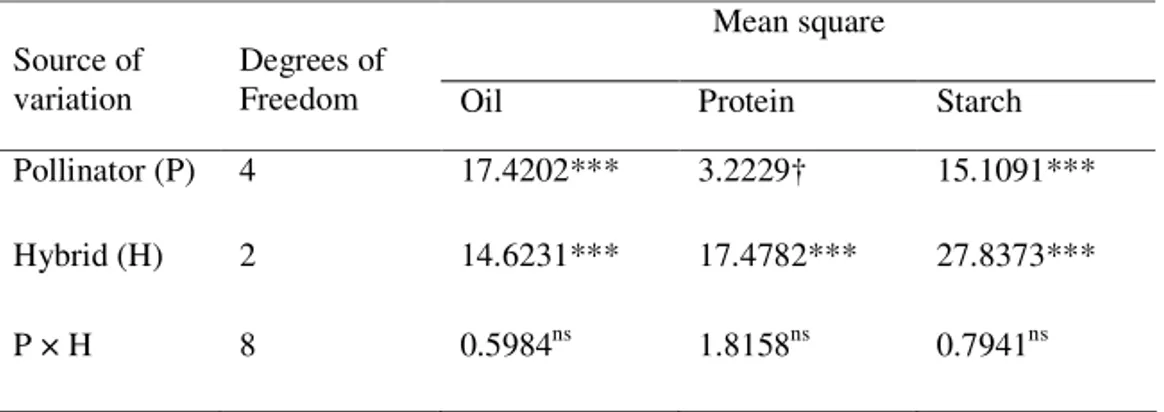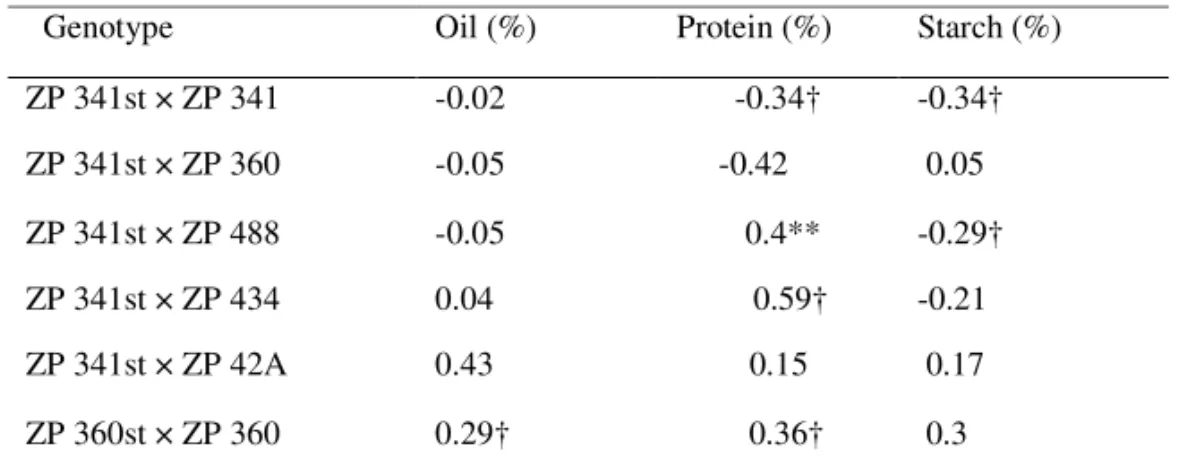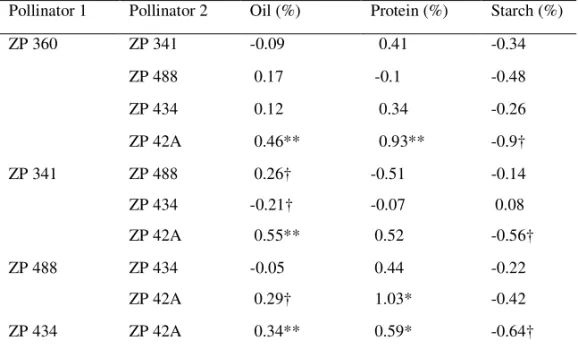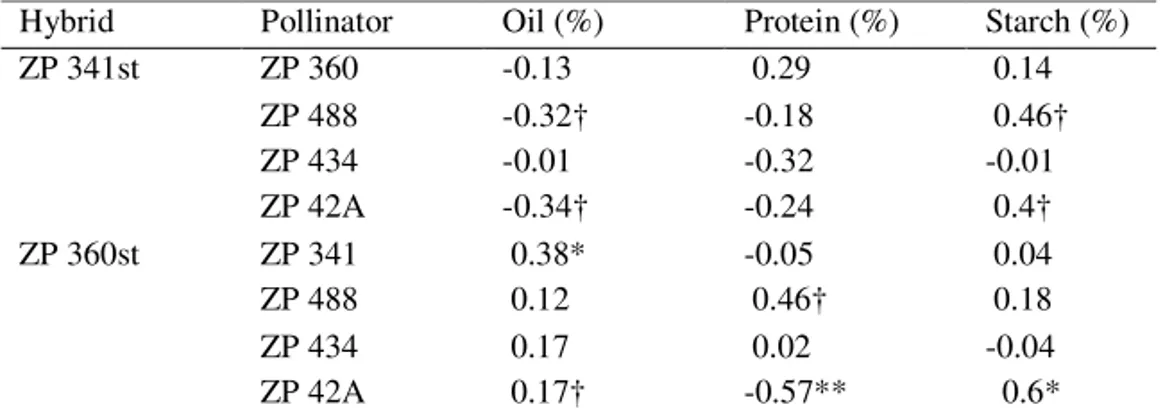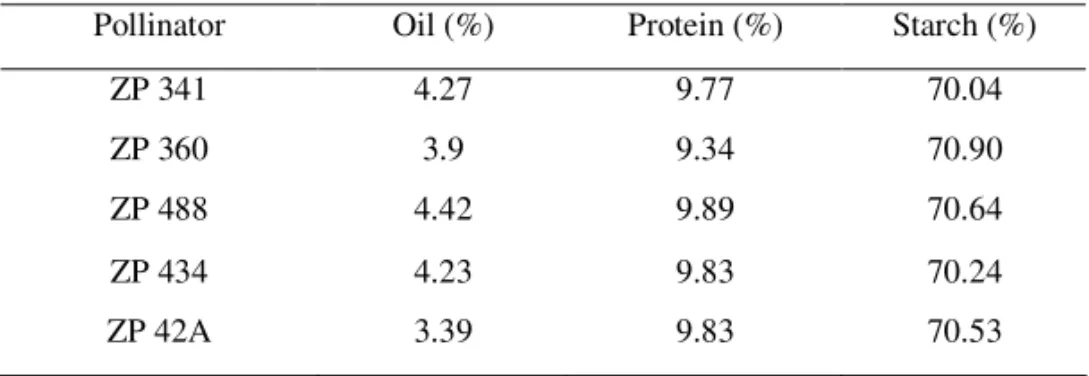______________________________
Corresponding author: Jelena Vančetović, Maize Research Institute, Zemun Polje,
Belgrade, Serbia, S. Bajića 1, 11185 Zemun Polje, Serbia
UDC 575: 633.15 DOI:10.2298/GENSR0901095V
Original scientific paper
THE EFFECTS OF CYTOPLASMIC MALE STERILITY AND XENIA ON THE CHEMICAL COMPOSITION OF MAIZE GRAIN
Jelena VANČETOVIĆ¹, Ljupcho JANKULOSKI2, Sofija BOŽINOVIĆ¹
and Dejan DODIG¹
1Maize Research Institute, Zemun Polje, Belgrade-Zemun, Serbia 2Faculty of Agricultural Science and Food, Skopje, Macedonia
Vančetović J., Lj.. Jankuloski, S. Božinović and D. Dodig
(2009): The effects of cytoplasmic male sterility and xenia on the chemical composition of maize grain – Genetika, Vol. 41, No. 1, 95-106.
Sterile hybrids often outyield their fertile counterparts, especially if pollinated by a genetically unrelated pollinator. The combined effect of cms and xenia is referred to as the Plus-hybrid effect. The objective of this study was to determine the individual, as well as, combining effect of cms and xenia on the maize grain chemical composition. The percent of oil, protein and starch in the grain was also observed.
Two sterile hybrids, their fertile counterparts and five fertile pollinator-hybrids were selected for the studies. The three-replicate trial set up according to the split-plot experimental design was performed at Zemun Polje in 2008.
The obtained results show that the effects of cms on the oil percent was not significant in the studied hybrid ZP 341, while it increased at the significance level of P = 0.1 in the second observed hybrid ZP 360. The effect of this factor on the protein and starch percent was also significant (P = 0.01) in some hybrid combinations. Xenia effects on all three chemical parameters were significant (P = 0.01) in some hybrid combinations. The gained results indicate that the identification of a good combination of two hybrids, in which one would be a sterile female component, and the other a pollinator, would end up not only in the increased yield, but also in the improved maize grain quality.
Key words: citoplasmic male sterility; grain quality; maize; plus
hybrid effect; xenia .
INTRODUCTION
The majority of studies dealing with the cms effects on maize grain yield showed that the yield of male sterile plants was higher by 5-10% on the average (ROGERS and EDWARDSON 1952, KALMAN et al., 1985) than the yield of fertile
plants, while some authors found out that the yield of male sterile hybrids was higher under stress conditions (DUVICK, 1965). STAMP et al. (2000) determined
higher yields of sterile hybrids at different nitrogen fertiliser rates, different water supplies and various cropping densities. These results can be explained by the fact that great amounts of nutrients and energy are necessary to form pollen, and since the sterile plant does not form pollen the nutrients are targeted to the grain formation. Xenia refers to the immediate effects of a foreign pollen parenton nonmaternal tissue of the kernel. Theembryo receives one half and the endosperm one third of itsgenome from the sperm; the former contributes 11% and the latter 83% to the dry weight of the kernel (TOLLENAAR and DWYER, 1999). Consequently, the potential positive effect of xenia on the grain yield is obvious. TSAI and TSAI (1990) and WEILAND (1992) detected that a grain yields increased significantly when sterile hybrids were crossed to unrelated fertile pollinator hybrids. If conventional breeding methods are applied for single cross hybrids, the kernels produced in plants of the F1 generation are actually of the F2 generation and the inbreeding depression is pronounced in the majority of them, hence cross-pollination to unrelated hybrids will increase grain heterozygosity that will probably affect its traits.
The xenia effect on grain quality was studied as far back as the beginning of the last century when the quality improvement in non-isogenically pollinated plants was observed by CORRENS (1901). The conclusion is that a gain is greater from xenia if the genetic distance between crossed materials is greater (BULANT and GALLAIS, 1998). The xenia effect has been used since the 1990s by the application of so called TopCross system (patented by the company DuPont Specialty Graines, Des
Moines, Iowa, USA). This system involves planting of a mixture of two types of maize (90% high yielding cms hybrids are mixed with 10% pollinators of high quality grain). The pollinator provides the increase of the embryo in the sterile hybrid, which leads to the quality improvement of maize grain. Such a system is important for the production of quality protein maize (QPM) (VASAL, 2001). A new approach, dating from the end of the 20th century consists of blending a sterile version of a yielding hybrid with a fertile version of unrelated hybrid with the aim to express a positive effect of cms and xenia. The combined effects of cms and xenia are referred to as the Plus-hybrid effect (WEINGARTNER et al., 2002a, b).
These authors determined the yield increased of 9.1% on the average, and they also tested grain quality of the same material (WEINGARTNER et al., 2004). Obtained
results showed that cms did not significantly affect the content of nitrogen and carbon, but xenia effects on the nitrogen content were significant and positive. The pollinator x female component interaction was significant. The protein yield can be increased concurrently with the grain yield even by 10%. Furthermore, the Plus-hybrid system can be used to prevent release of pollen from genetically modified plants by growing mixtures of genetically modified cms hybrids and genetically modified fertile hybrids (FEILet al, 2003).
The aim of this study was to determine individual, as well as, combined (Plus-hybrid) effect of cms and xenia on the content of oil, protein and starch. Furthermore, gained results can possibly point to hybrids of good general pollinator abilities (GPA; provide the highest value of studied traits with female components in the trial), as well as, combinations of hybrids with good specific pollinatorability (the combination that is better than expected on the basis of GPA of the male component and the average values of the female component traits).
MATERIAL AND METHODS
Two sterile hybrids, ZP 341st and ZP 360st, and their fertile counterparts were used in the study. Also, the following five fertile hybrids with normal N cytoplasm: ZP 341, ZP 360, ZP 42A, ZP 434 and ZP 488 were used as pollinators. The selected hybrids are early maturing and belong to the FAO maturity 300-400 and therefore they avoid drought under conditions of our country. Also, a special attention was paid to their synchronous flowering.
The three-replicate experiment was carried out according to the randomised complete-block (RCB) split-plot design in the location of Zemun Polje during 2008. The observed female components represented the main plots (sterile and fertile versions of the hybrids ZP 341 and ZP 360), provided that detasseling was performed on fertile female components and they were used only for the estimation of cms effects in the trial. Subplots were made of fertile pollinator hybrids. Each subplot consisted of 14 rows, each 18 m long. The row distance was 0.75 m and the crop density amounted to 77,220 plants ha-1. The female component was sown in the middle two rows, sown with a particular pollinator, on the distance of 3.7 m from the upper and the bottom part of the plot. The error occurred at
harvest of the fourth block sown with the female-fertile hybrid ZP 360, hence the data obtained from this block when traits were analysed were not considered. The trial was sown mechanically and harvested manually.
The percent of oil, protein and starch content was observed, and these traits were determined for female and male components within subplots. The male component traits were related to the Plus-hybrid effects, and based on it, it was determined whether they could be used for the prediction of these effects. In practice, a mixture of cms hybrids and pollinator hybrids is grown, hence the traits of the fertile hybrid in the blend affect the value of the grown hybrid mixture. The following three effects were monitored for each trait: 1. cms effect: the difference between the average value of the performance of a fertile and isogenically pollinated sterile hybrid (pollinated by pollen of its fertile counterpart) for hybrids
per se, that is a difference between the average value of the performance of a
non-isogenically pollinated fertile hybrid (pollinated by pollen of unrelated genotype) and a non-isogenically pollinated sterile hybrid with the same pollinator for combinations of sterile hybrids and non-isogenic pollinators. The cms effect was the only effect possible to estimate for the hybrid ZP 360 for the hybrid per se, and
instead of the average value of the performance of the fertile isogenically pollinated ZP 360 hybrid, the average value of the performance of this hybrid was taken form the subplots where this hybrid was a pollinator, i.e. the male component (the average values within each block, then the total average of all three blocks) 2. xenia effect: the difference between the average values of the performance of a nonisogenically pollinated hybridand isogenically pollinated cms hybrid. 3. Plus-hybrid effect: the difference between the average value of the performance of a fertile isogenically pollinated hybrid and a sterile non-isogenically pollinated hybrid. The general pollinator ability (GPA) was observed by measuring the average value of the performance under the influence of a certain pollinator. Moreover, the specific pollinator ability (SPA) was also observed. The SPA is related to the combinations of the female component and the pollinator that had a better average performance than would be expected based on the average performance of the two components involved.
The chemical composition of samples was analysed by the Infratec 1241 Grain Analyser (FOSS TECATOR, Sweden). To correct for non-normality all statistical analyses were done on arcsine transformed values of studied traits. The analysis of variance (ANOVA) for a randomised complete block (RCB) split-plot design was applied (MSTAT-C). A t-test was performed to test the significance of
differences between the means.
RESULTS AND DISCUSSION
The results of ANOVA point to a strong influence of a pollinator and female-hybrid on the maize grain chemical composition (Table 1).
Table 1. ANOVA of oil, protein and starch content in maize kernels Mean square Source of
variation Degrees of Freedom Oil Protein Starch
Pollinator (P) 4 17.4202*** 3.2229† 15.1091***
Hybrid (H) 2 14.6231*** 17.4782*** 27.8373***
P × H 8 0.5984ns 1.8158ns 0.7941ns
P – hybrids used as pollinators. H – hybrids used as mothers.
ns- non significant, † - significant at the 0,1 probability level, *** - significant at the 0.001 probability
level.
The pollinator effect on the content of oil and starch was at the significance level of P = 0.001, and was also significant (P = 0.1) on the protein content. The effect of the female-hybrid on all three traits was at the significance level of P = 0.001. The pollinator × female component interaction was not significant for any of observed traits.
The negative cms effect on the hybrid ZP 341 was detected for the content of proteins and starch, while the oil content was also somewhat lower, but it was not statistically significant (Table 2). The cms differently affected the oil content in different combinations of the hybrid ZP 341 with pollinators, but neither of changes in the trait showed statistical significance. The significant percent increase in grain protein content of 0.4% and 0.59% occurred in the combinations of the hybrid ZP 341st with the hybrids ZP 488 (P = 0.01) and ZP 434 (P = 0.1), respectively. The protein percent decreased in the ZP 341st × ZP 360 combination, but this change was not statistically significant. The cms depressively affected the starch percent only in the ZP 341st × ZP 488 combination (P = 0.1), while its effect on other combinations was not statistically significant. The positive cms effects on the hybrid ZP 360 were detected for all three traits (P = 0.1). These effects were not statistically significant only in relation to starch. This points out that the smallest, i.e. largest cms effect was on the grain oil content, i.e. protein content, respectively. This implies not only to hybrids per se but also to different
combinations of two hybrids. Furthermore, considering that the cms effect on all three observed traits in the hybrid ZP 360 was positive, it can be concluded that this effect can be more employed for this hybrid than for the hybrid ZP 341.
Table 2. Cms effect on oil, protein and starch percentage in kernels
Genotype Oil (%) Protein (%) Starch (%)
ZP 341st × ZP 341 -0.02 -0.34† -0.34† ZP 341st × ZP 360 -0.05 -0.42 0.05 ZP 341st × ZP 488 -0.05 0.4** -0.29† ZP 341st × ZP 434 0.04 0.59† -0.21 ZP 341st × ZP 42A 0.43 0.15 0.17 ZP 360st × ZP 360 0.29† 0.36† 0.3
Values (%) of oil, protein and starch indicate changes relative to the male-fertile hybrid, isogenically pollinated.
†- significant at the 0,1 probability level, * - significant at the 0,05 probability level., ** - significant at the 0,01 probability level.
The xenia effect on the grain oil of the hybrid ZP 341st was significantly negative (P = 0.01) for three pollinators, while only the pollinator ZP 434 positively affected this trait, though this effect was not significant (Table 3). Moreover, on the basis of comparison of different combinations of the hybrid ZP 341st and nonisogenic pollinators it can be concluded that the highest grain oil percent was obtained when the hybrid ZP 434 was used as a pollinator. This combination expresses good specific pollinator ability, as the hybrid ZP 341 came out as the best general pollinator (Table 4). The increase of the protein content of ZP 341st was affected by all four pollinators, but only the hybrid ZP 360 significantly affected this trait (P = 0.1). Protein content increased by 0.63%. This hybrid also showed the best GPA, while the ZP 341st × ZP 360 combination had a higher protein content than other combinations (P = 0.1). The xenia effect on grain starch percentage was positive for all four pollinators at the significance level of P = 0.01. The hybrid ZP 488 was the best general pollinator for the grain starch content, and this combination was better than all others and had the starch percent higher by 0.8%.
WEINGARTNER et al., (2004) observed the cms effects on grain quality and detected the increase of the protein content in all three observed hybrids in relation to their fertile counterparts. However, results obtained in our study show that the increase of the protein percent affected by cms occurred only in one observed hybrid (ZP 360). The xenia effect on the protein percent was significant (P = 0.01) in both observed hybrids in our trial, but it differed in relation to the used pollinator. Similar results were obtained by WEINGARTNER et al., (2004). These results show that one sterile nonisogenically pollinated hybrid had a reduced protein content, while remaining two hybrids had the increased protein content, but not significantly. Four out of 15 Plus-hybrid combinations observed by WEINGARTNER et al., (2004) had significantly higher grain protein content than
their isogenically pollinated counterparts. Three out of 10 Plus-hybrid combinations observed in our study had increased content of the grain protein in relation to their fertile isogenically pollinated counterparts, but the significant increase was detected only in one hybrid (P = 0.1).
Table 3. Xenia effect on oil, protein and starch percentage in maize kernels for hybrid ZP 341 per se and for different ZP 341× pollinator combinations.
Pollinator 1 Pollinator 2 Oil (%) Protein (%) Starch (%)
ZP 341 ZP 360 0.11* -0.63† -0.48* ZP 488 0.3** -0.16 -0.8** ZP 434 -0.01 -0.02 -0.32† ZP 42A 0.32** -0.1 -0.74** ZP 360 ZP 488 0.19* 0.47† -0.32† ZP 434 -0.12† 0.51† 0.16 ZP 42A -0.21* 0.53† -0.26† ZP 488 ZP 434 -0.31* 0.14 0.48** ZP 42A 0.02 0.06 0.06 ZP 434 ZP 42A 0.33** -0.08 -0.42**
Values (%) for oil, protein and starch indicate differences between ZP 341 hybrid pollinated with pollinator 1 and 2.
†- significant at the 0,1 probability level, * - significant at the 0,05 probability level, ** - significant at the 0,01 probability level.
Table 4 . General pollinator ability for oil, protein and starch content of five hybrids used as a pollinators.
Pollinator Oil (%) Protein (%) Starch(%)
ZP 341 4.42 9.9 70.06
ZP 360 4.33 10.2 70.14
ZP 488 4.14 9.93 70.62
ZP 434 4.34 9.62 70.21
When the hybrid ZP 42A was used as a pollinator the xenia effect on the oil content was significantly negative (P = 0.01), and only the hybrid ZP 341 had positive insignificant effect on the oil percent in the grain (Table 5). Similar to the hybrid ZP 341st, the ZP 360st × ZP 434 combination had good specific pollinator ability in the hybrid ZP 360st, although it was no as good as in the isogenically pollinated hybrid ZP 360st. The protein percent was significantly reduced under the influence of the pollinator ZP 42A (P = 0.01), but only the hybrid ZP 488 positively, but not significantly affected this trait. The combination of the sterile hybrid ZP 360 and the pollinator hybrid ZP 488 had the best specific pollinator ability for the grain protein percent. The effects of all pollinators on the grain starch percent were positive, while the effect of the hybrid ZP 42A on this trait was significant (P = 0.1) (the relative starch content increased by 0.9%). The hybrid ZP 360st pollinated by this pollinator was characterised with the greatest starch percent when compared with other combinations.
Table 5. Xenia effect on oil, protein and starch percentage in kernels for different hybrid × pollinator combinations for ZP 360.
Pollinator 1 Pollinator 2 Oil (%) Protein (%) Starch (%)
ZP 360 ZP 341 -0.09 0.41 -0.34 ZP 488 0.17 -0.1 -0.48 ZP 434 0.12 0.34 -0.26 ZP 42A 0.46** 0.93** -0.9† ZP 341 ZP 488 0.26† -0.51 -0.14 ZP 434 -0.21† -0.07 0.08 ZP 42A 0.55** 0.52 -0.56† ZP 488 ZP 434 -0.05 0.44 -0.22 ZP 42A 0.29† 1.03* -0.42 ZP 434 ZP 42A 0.34** 0.59* -0.64†
Values (%) for oil, protein and starch indicate differences between ZP 360 hybrid pollinated with pollinator 1 and 2.
†- significant at the 0,1 probability level, * - significant at the 0,05 probability level, ** - significant at the 0,01 probability level.
The Plus-hybrid effect had a negative influence on the hybrid ZP 341 for five pollinator hybrids on the grain oil percent (P = 0.1), while only the hybrid ZP 341st pollinated by the hybrid ZP 360 showed a positive combined cms and xenia effect on the protein percent, but this effect was not at the level of significance (Table 6).
Table 6. Plus-hybrid effect on oil, protein and starch percentage in kernels
Hybrid Pollinator Oil (%) Protein (%) Starch (%)
ZP 341st ZP 360 -0.13 0.29 0.14 ZP 488 -0.32† -0.18 0.46† ZP 434 -0.01 -0.32 -0.01 ZP 42A -0.34† -0.24 0.4† ZP 360st ZP 341 0.38* -0.05 0.04 ZP 488 0.12 0.46† 0.18 ZP 434 0.17 0.02 -0.04 ZP 42A 0.17† -0.57** 0.6*
Values (%) on oil, protein and starch indicate changes relative to the male-fertile hybrid, isogenically pollinated.
† - significant at the 0,1 probability level, * - significant at the 0,05 probability level, ** - significant at the 0,01 probability level.
In contrast to a depressive Plus-hybrid effect on the percent of oil and protein, only one Plus-hybrid combination (ZP 341st × ZP 434) had a negative insignificant effect on the starch percent. The ZP 341st × ZP 360 combination would be the best Plus-hybrid effect on the observed hybrid ZP 341, as values of two out of three studied traits were higher, while the value of the third trait was not significantly lower. Each Plus-hybrid combination for the hybrid ZP 360 had the increased grain oil percent, while ZP360st × ZP 341 and ZP 360st × ZP 42A combinations had significant increase of this matter (P = 0.05) in relation to the fertile hybrid ZP 360. Two Plus-hybrid combinations showed a lower protein percent in relation to the ordinary hybrid ZP 360 (ZP 360st × ZP 42A significant at the level of 0.01), and another two combinations had a higher protein content (ZP 360st × ZP 488, significant at the level of 0.1). The ZP 360 × ZP 434 combination has reduced grain starch content, but this content was not at the level of significance. The significant increase of this content was detected only in the ZP 360st × ZP 42A combination (P = 0.05). According to the gained results it can be concluded that the Plus-hybrid effect was the best for the observed ZP 360 ZP 360st × ZP 488 combination, as the values of all three studied traits were increased, while one value was significantly increased (P = 0.1).
The lowest grain oil percent was detected in the male-pollinator hybrid ZP 42A (Table 7), while the Plus-hybrid ZP 341st × ZP 42A combination had a significantly lower grain oil percent (P = 0.1) in the fertile isogenically pollinated hybrid ZP 341 (Table 6). On the other hand, the Plus-hybrid ZP 360st × ZP 42A combination had a somewhat higher grain oil content in relation to the fertile hybrid ZP 360. The highest grain oil percent was recorded in the pollinator hybrid ZP 488, but the expected increase of the grain oil percent in the Plus- hybrid combinations of the observed hybrids failed. This point out that the male component performance for the grain oil percent cannot be used for the prediction of the Plus-hybrid effects for this trait. The same can be concluded for the protein percent - the greatest value was recorded in the male-hybrid ZP 488, but the
Plus-hybrid ZP 488 × ZP 341st combination had a lower protein percent (Table 7), while the ZP 488 × ZP 360st combination had a significantly higher value of this trait (P = 0.1). The lowest grain protein percent was found in the male-hybrid ZP 360, but this hybrid, as would have been expected, did not significantly affect this trait. Also, the male-hybrid ZP 434 with the lowest starch percent in the Plus-hybrid combinations with studied female-Plus-hybrids, did not significantly reduce the percent of this matter in the grain. These data point out that none of the studied traits could be predicted by the Plus-hybrid effect based on the performances of male-hybrids used in combinations.
Table 7. Percentage of oil, protein and starch in kernels of hybrids used as pollinators
CONCLUSION
The Plus-hybrid combinations in our studies showed different results depending on the observed hybrid and the trait. As the oil percent for all hybrid combinations with the hybrid ZP 341 was lower, the value of this trait for combinations with the hybrid ZP 360 was higher than in the hybrid ZP 360 with normal cytoplasm. The protein, as well as, starch percent varied over combinations. It can be concluded that the yield increase of the Plus-hybrid combinations does not necessarily mean a significant grain quality debasement. If a good combination is selected even a higher grain quality can be expected. Therefore, further research is required to identify possible good Plus-hybrid combinations that could lead Serbia to the commercial production.
ACKNOWLEDGEMENT
This research was supported by the Ministry of Science and Technology, Republic of Serbia, through Project TR.
Received February 28th, 2009
Accepted March 25h, 2009
Pollinator Oil (%) Protein (%) Starch (%)
ZP 341 4.27 9.77 70.04
ZP 360 3.9 9.34 70.90
ZP 488 4.42 9.89 70.64
ZP 434 4.23 9.83 70.24
REFERENCES
BULANT, C. and A. GALLAIS (1998): Xenia effects in maize with normal endosperm: I. Importance and stability. Crop Sci. 38: 1517 - 1525.
CORRENS, C. (1901): Bastarde zwischen Maisrassen, mit besonderer Berücksichtigung der Xenien. Verlag von Erwin Nägele, Stuttgart, Germany.
DUVICK, D. N. (1965): Cytoplasmic pollen sterility in corn. Adv. Genet. 13, 1-56.
FEIL, B., U. WEINGARTNER and P. STAMP (2003): Controlling the release of pollen from genetical modified maize and increasing its grain yield by growing mixtures of sterile and male-fertile plants. Euphytica 130: 163-165.
KALMAN, L., L. PINTER and Z. PINTER (1985): Comparative study on major agronomic characteristics of male fertile (normal) and cytoplasmic male sterile aanlogues in maize (Zea Mays L.). Acta Agron. Acad. Sci. Hung. 34: 128-134.
ROGERS, J. S., J. R., EDWARDSON (1952): The utilization of cytoplazmic male-sterile inbreds in the production of corn hybrids. Agron. J. 44, 8-13.
STAMP, P., S. CHOWCHONG, M. MENZI, U. WEINGARTNER, O. KAESER (2000): Increase in the yield of cytoplasmic male sterile maize revisited. Crop Sci. 40, 1586-1587.
TOLLENAR, M., L. M. DWYER (1999): Physiology of maize. In D.L. Smith and C. Hamel (ed) Crop yield,
physiology and processes. Springer-Verlag, Berlin.
TSAI, C. L., C. Y. TSAI (1990): Endosperm modified by cross-pollinating maize to induce changes in dry matter and nitrogen accumulation. Crop Sci. 30, 804-808.
VASAL, S. K. (2001): High quality protein corn. In: Arnel R. Hallauer (Ed.), Specialty corns. CRC Press, Boca Raton, FL, pp. 86-129.
WEILAND, R. T. (1992): Cross-pollination effects on maize (Zea Mays L.) hybrid yields. Can. J. Plant Sci. 72, 27-33.
WEINGARTNER, U., O .KAESER, M. LONG, P. STAMP (2002a): Combining male sterility and xenia increases grain yield of maize hybrids. Crop Sci. 42, 127-134.
WEINGARTNER, U., T.J.PREST, K.-H.CAMP, P. STAMP (2002b): The plus-hybrid system a method to increase grain yield by combined cytoplasmic male sterility and xenia. Maydica 47, 127-134. WEINGARTNER, U., K.-H. CAMP P.STAMP (2004): Impact of male sterility and xenia on grain quality traits
UTICAJ CITOPLAZMATSKE MUŠKE STERILNOSTI I KSENIJA NA HEMIJSKI SASTAV ZRNA KUKURUZA
Jelena VANČETOVIĆ¹, Ljupcho JANKULOSKI², Sofija BOŽINOVIĆ¹,
i Dejan DODIG¹
1Institut za kukuruz „Zemun Polje“-Beograd, Srbija ²Faculty of Agricultural Science and Food, Skopje, Makedonija
I z v o d
Sterilni hibridi često imaju veći prinos od svojih fertilnih analoga,
posebno ako su oprašeni sa genetski nesrodnim oprašivačem. Kombinovani uticaj
cms-a i ksenija se naziva Plus hibrid efekat. Cilj ovog istraživanja bio je da se utvrdi kakav je pojedinačni, kao i kombinovani uticaj cms-a i ksenija na hemijski
sastav zrna kukuruza. Ispitivani su procenat ulja, proteina i skroba u zrnu.
Za istraživanja su odabrana dva sterilna hibrida, njihovi fertilni analozi i pet fertilnih hibrida oprašivača. Ogled je izveden u Zemun Polju 2008. godine i bio je
postavljen po slučajnom blok split-plot eksperimentalnom dizajnu u tri
ponavljanja.
Rezultati pokazuju da uticaj cms-a na udeo ulja nije bio značajan za ispitivani
hibrid ZP 341, dok je drugi ispitivani hibrid ZP 360 imao povećanje udela ulja u
zrnu na nivou značajnosti P = 0,1. Efekat ovog faktora na udeo proteina i skroba
takođe je pokazivao značajnost (P = 0,01) u nekim hibridnim kombinacijama.
Ksenije su značajno (P = 0,01) uticale na sva tri hemijska parametra u nekim
hibridnim kombinacijama. Rezultati upućuju da bi se pronalaskom dobre
kombinacije dva hibrida, u kojoj bi jedan bio sterilna majka, a drugi polinator, pored povećanja prinosa, mogao poboljšati i kvalitet zrna kukuruza.
Primljeno 28. II 2009.
